
Peperomia is one of the two large genera of the family Piperaceae. It is estimated that there are at least over 1,000 species, occurring in all tropical and subtropical regions of the world. They are concentrated in South and Central America, but may also be found in southern North America, the Caribbean islands, Africa, Oceania, and southern and eastern parts of Asia. The exact number of species is difficult to determine, as some plants have been recorded several times with different names, and new species continue to be discovered. Peperomias have adapted to many different environments and their appearances vary greatly. Some are epiphytes or lithophytes, and many are xerophytes or possess underground tubers (geophytes). Most species are compact perennial shrubs or vines.

Mosasaurus is the type genus of the mosasaurs, an extinct group of aquatic squamate reptiles. It lived from about 82 to 66 million years ago during the Campanian and Maastrichtian stages of the Late Cretaceous. The genus was one of the first Mesozoic marine reptiles known to science—the first fossils of Mosasaurus were found as skulls in a chalk quarry near the Dutch city of Maastricht in the late 18th century, and were initially thought to be the bones of crocodiles or whales. One skull discovered around 1780, which was seized by France during the French Revolutionary Wars for its scientific value, was famously nicknamed the "great animal of Maastricht". In 1808, naturalist Georges Cuvier concluded that it belonged to a giant marine lizard with similarities to monitor lizards but otherwise unlike any known living animal. This concept was revolutionary at the time and helped support the then-developing ideas of extinction. Cuvier did not designate a scientific name for the new animal, and this was done by William Daniel Conybeare in 1822 when he named it Mosasaurus in reference to its origin in fossil deposits near the Meuse River. The exact affinities of Mosasaurus as a squamate remain controversial, and scientists continue to debate whether its closest living relatives are monitor lizards or snakes.

Peperomia graveolens, commonly known as Ruby Glow, is a species of plant in the genus Peperomia of the family Piperaceae. It is endemic to Ecuador.
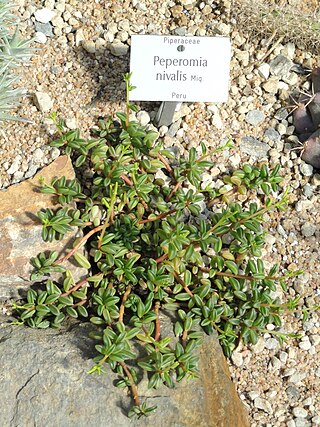
Peperomia nivalis is a species of plant in the genus Peperomia endemic to Peru. Its native habitat is found in the high altitude ranges of the peruvian Andes. P. nivalis is a compact erect succulent herb with fleshy stems and leaves. The thick leaves are cuneate and U-shaped in cross-section with epidermal windows on the top-side. The leaf color is bright green in the shady summer and reddish during dry sunny seasons.

Peperomia pellucida is an annual, shallow-rooted herb, usually growing to a height of about 15 to 45 cm, it is characterized by succulent stems, shiny, heart-shaped, fleshy leaves and tiny, dot-like seeds attached to several fruiting spikes. It has a mustard-like odor when crushed.

Boechera hoffmannii is a rare species of flowering plant in the family Brassicaceae known by the common name Hoffmann's rockcress. It is endemic to the Channel Islands of California, where it is known from only three or four populations on two of the eight islands. A 2005 report estimated a remaining global population of 244 individual plants. It is a federally listed endangered species.
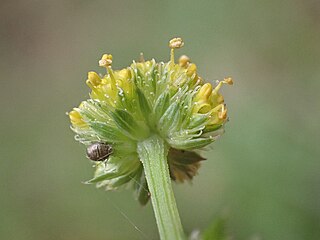
Sanicula hoffmannii is an uncommon species of flowering plant in the family Apiaceae known by the common names Hoffmann's blacksnakeroot and Hoffmann's sanicle. It is endemic to California, where it is known from the Channel Islands and a few locations in the coastal mountain ranges of the mainland, including the Scott Creek watershed in Santa Cruz County. Its habitat includes coastal hillsides and mountain slopes, sometimes with serpentine soils. It is a perennial herb producing a thick stem up to 90 centimeters tall from a taproot. The green or bluish leaves are compound, the blades each divided into about three lobed, toothed leaflets. The inflorescence is made up of one or more heads of bisexual and male-only flowers with tiny, curving, yellow-green petals.

Peperomia tetraphylla, known as the acorn peperomia or four-leaved peperomia, is a small plant in the Peperomia genus and the Piperaceae family that grows natively in tropical and subtropical regions around the world. Additionally in can found on Easter Island as an introduced species.

Peperomia obtusifolia, also known as the baby rubberplant, American rubber plant, or pepper face, is a species of flowering plant in the genus Peperomia under the family Piperaceae, native to Florida, Mexico and the Caribbean. The specific epithet obtusifolia means "blunt-leaved". The plant has gained the Royal Horticultural Society's Award of Garden Merit.
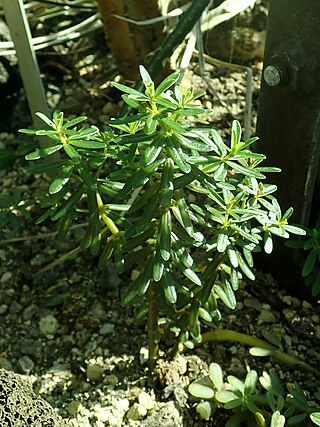
Peperomia galioides is a species of plant in the family Piperaceae, native to Mexico, Central America and South America. P. galioides has petioles of less than 1mm long and leaves between 5-30mm. There has been research in Colombia and Peru to know about the essential oils of this species. It was traditionally used in Peruvian herbal medicine.
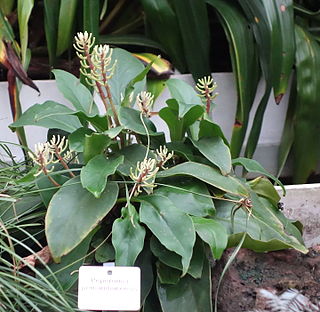
Peperomia pernambucensis is a species of plant in the genus Peperomia in the family Piperaceae. Its native range is in Central and South America from Nicaragua to Bolivia.
The anthophytes are a grouping of plant taxa bearing flower-like reproductive structures. They were formerly thought to be a clade comprising plants bearing flower-like structures. The group contained the angiosperms - the extant flowering plants, such as roses and grasses - as well as the Gnetales and the extinct Bennettitales.
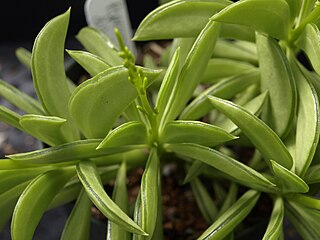
Peperomia dolabriformis is a species of plant in the genus Peperomia in the family Piperaceae. The species is also known as prayer pepper. The plant is used as an ornamental houseplant. It is native to Ecuador and Peru.

Peperomia serpens, the vining peperomia, is a species of flowering plant in the genus Peperomia and family Piperaceae, native to the New World Tropics. The plant is perennial.

Peperomia nitida is a species of plant in the genus Peperomia. Its native range is in South America from Brazil to northern Argentina. It can be kept as a houseplant and is sometimes sold as cupid peperomia, or problematically as Peperomia scandens or Peperomia serpens.
Peperomia macrorhiza is a species of plant in the genus Peperomia. It is endemic to Peru. It is a geophytic plant, storing water and reserves in an underground tuber. During dry periods parts above ground, such as leaves, will wither away but the plant will survive due to the tuber. When more rain falls the plant regrows its stalks and leaves on the surface.

Peperomia quadrangularis, commonly known as the beetle peperomia, is a species of plant in the genus Peperomia of the family Piperaceae. Its native range is in tropical America, including areas in northern South America, Central America and the West Indies.

Peperomia glabella, commonly known as the cypress peperomia or wax privet, is a species of plant in the genus Peperomia of the family Piperaceae. Its native range is from southern North America to central South America. Three varieties are known. In addition to the basic one they are P. glabella var. nudipetiolata and P. glabella var. obtusa (Steyerm.).

Peperomia orba is a species of plant in the genus Peperomia of the family Piperaceae.

















